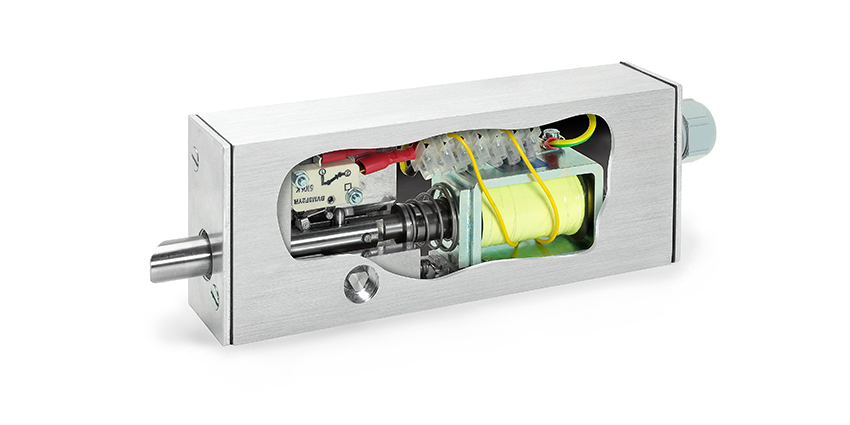Straightforward security measures
However, while locking can be one of the simplest security initiatives, it’s also capable of being among the most complex where sophisticated measures are called for. In part two, we will cover specialised electric locking technologies and some more unusual security solutions and application examples.
Among straightforward security measures is remote locking
Among straightforward security measures is remote locking – a function found almost everywhere you look. Unless you’re the proud owner of a classic car, when did you last physically put your vehicle key in the door lock? Remote locking ups the ante for designers who need to incorporate security in an assembly, an application, a product or a system.
Solenoid workhorses
Solenoid actuators and electromagnet technologies are the bedrock of electric locks. Remote operation – activating a lock from a distance – is commonplace. Wireless RF transmitters in the key fobs of modern vehicles activate the central locking system. Cards with embedded RFID chips, fingerprint readers and facial recognition systems provide selective access to buildings, typically by either actuating a solenoid lock or releasing a powerful door magnet. You can see examples on the Jubilee and the new Elizabeth (Crossrail) lines on the London Underground. They use electric solenoid-based locks to secure platform access screen doors, only allowing them to open once the tube train has arrived.
Solenoid-based electric locking is at the heart of safety-based security in applications such as lift doors and disabled access lifts, on building hoists, and as interlocking systems for screens and safety covers on machine tools, to name a few.
Solenoid-based electric locking is at the heart of safety-based security
These are straightforward applications that address a range of issues that come under the general heading of security. Others demand special features built into the electric locking mechanism to meet specific end user requirements. This added complexity can present a design challenge to the inexperienced. Electro-mechanical design engineers invariably have a useful broad knowledge for developing products but not necessarily a core expertise in solenoid technology.
One example we like to use is a railway carriage. To design and build that takes a huge breadth of knowledge and expertise due to the many systems and assemblies a carriage comprises. But passenger trains now feature remote electric door locking which must function perfectly – and without which the rolling stock is unfit for purpose. That electric locking subassembly design is a critical feature and a specialist development project.
 |
| Solenoid actuators and electromagnet technologies are the bedrock of electric locks |
Shotbolts
A generic term used for electric solenoid locks is shotbolts. In these linear actuating units, the solenoid typically moves the bolt directly or through a bell crank to turn the actuation through 90 degrees, or to extend the linear movement of the bolt. They can be built as Fail-safe or Fail-secure models, meaning energise-to-lock, or energise-to-release respectively, which determines the state they adopt in the absence of power.
You would want some applications to default to unlock in the event of power loss, and others to default to the locked state. Both types usually deploy a spring to return the bolt in the quiescent unenergised state. Bi-stable is another functionality available. In this design, no power is consumed in either position. A loss of power will leave the device in its last state.
Scaling down
Some shotbolts are large. Those designed to secure the access ramp on the Solent hovercraft built by Griffon Hoverwork are powerful units – and in that application a weatherproof design is deployed to withstand the saltwater spray and frequent washdowns. But a shotbolt and the solenoid contained within it can be physically quite small and require minimal power, yet still provide highly secure locking in a mortice lock arrangement.
This is where the locking assembly starts to become complex
Over the years, bespoke designs have been developed for diplomatic bags and Cash In Transit (CIT) cases. Both use small, low power actuators. In the latter application by specialist Cash In Transit equipment manufacturers HDH, intelligent electric lock technology provides unique features – and there’s a range of surprises in store for anyone accessing cash boxes illicitly. Technologies in cash transit solutions include GPS tracking, alarms, remote monitoring and automatic ‘cash degradation’ systems if a case is forced open.
Ensuring that degradation systems don’t activate when a case is opened legitimately is equally important. This is where the locking assembly starts to become complex, requiring special design expertise. The CIT solenoid lock uses a 90°actuator to latch, lock and arm automatically if required but can be set to not lock or arm as the actuator travel doesn’t engage with the mechanical latch mechanism by default. Integrated technology solutions inside the case include daylight sensors, surface protection wires inside and out, and reed switches between the lid and the base. All contribute to safety precautions that prevent accidental activation and protect the valuable cargo and the operator. But for first line security, straightforward shotbolt electric locking is still at the heart of CIT cases.
Internet of Things
Miniature shotbolts are also used in some medical ventilators – a topical subject at the time of writing during the global coronavirus pandemic. They are also increasingly appearing in consumer-level Internet of Things (IoT) applications, being a key component in home automation applications.
Our goal at Magnet Schultz is to provide a clearer insight into today’s electric locking industry sector and the wide range of locking solutions available. We dealt with some straightforward technologies and applications here. In part two, we will look at special technologies built into more sophisticated solenoid locks to prevent forced entry, at materials that guard against explosion risks in hazardous environments and even at the use of proportional solenoid technology to manage pressurised gases.
Read part two of this feature here.
Stay ahead of the trends on securing physical access control systems through layered cybersecurity practices.


























